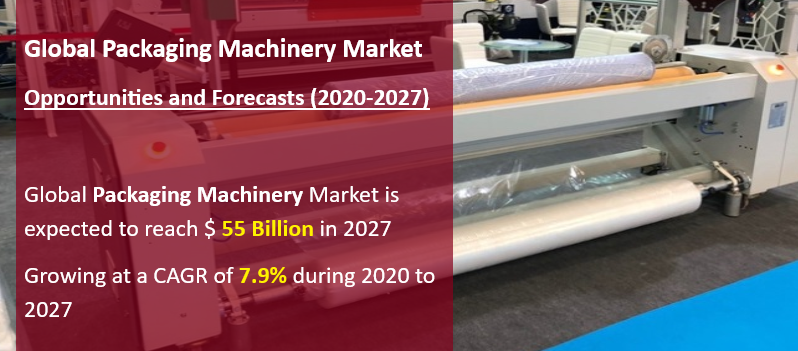Report Overview.
The report will cover the overall analysis and insights in relation to the size and growth rate of the ” Global Packaging Machinery Market ” by various segments at a global and regional level for the 2014-2027 period, with 2014-2018 as historical data, 2019 as a base year, 2020 as an estimated year and 2020-2027 as forecast period.
Packaging machinery is used throughout all packaging operations, involving primary packages to distribution packs. This includes many packaging processes fabrication, cleaning, filling, sealing, combining, labeling, overwrapping, palletizing.
COVID 19 Impacts on Packaging Machinery Market
COVID-19 is a new strain of coronavirus that has not been previously identified in humans . Coronaviruses (CoV) are a family of RNA (ribonucleic acid) viruses. COVID-19 started in Asia and is now spreading over the rest of the world via person-to-person contact and community spread. COVID-19 pandemic may have an potential impacts on Packaging Machinery Market.

Report Includes
- The report provides information about the current and upcoming trends in the market from 2020 to 2027, which helps determine the prevailing opportunities.
- The report highlights significant factors constantly determining growth of the packaging machinery market, offering untapped opportunities for manufacturers along with trends and developments, and other key insights across various key segments.
- The report includes information related to key drivers, restraints, and opportunities with a detailed impact analysis.
- 144 Market data Tables and 25 Figures.
- Up-to-date analyses of competitive developments, such as expansions, joint ventures, new products launches, expansions, and mergers & acquisitions in the global personal protective equipment market.
- Key market players within the market are profiled in this report and their strategies are analyzed thoroughly, which help understand the competitive outlook of the global market.
- The study enumerates vital market dynamics, such as key drivers, challenges, and trends, along with opportunities in the global packaging machinery market.
- A comprehensive study on the supply chain, which includes service providers and end users, is included in the global packaging machinery market report.
- The report delivers an exhaustive assessment on the structure of the packaging machinery market, in tandem with a dashboard view of all leading company profiles included in the report.
- Macroeconomic factors that are directly or indirectly affecting the growth of the market are also included in the report.
Scope of the reports
Technological innovations are likely to boost market growth. However, challenges of floorspace and accuracy of machines act as a barrier for packaging companies, especially in the pharmaceutical landscape. Novel machines are being manufactured to target small pharmaceutical manufacturers Hence, companies are introducing new liquid unit-dosing cup machines that ensure accuracy in packaging of controlled substance without sacrificing the and contract development & manufacturing organizations (CDMOs).
Innovative packaging machinery has helped manufacturers to save cost on time and manpower. Companies in the packaging machinery market are introducing latest technologies for sterile filling. For instance, special manufacturer of primary packaging Lameplast, presented their new machinery Pentafill A25- an automatic sealing and filling machine designed to function in sterile environments.
Currently, there is a growing demand for single-dose unit packaging in the market for packaging machinery. Companies are increasing research to induce versatility in these novel filling & dosing machines. Stakeholders in various end markets are benefitting from the advantages of compact machines that fit in small rooms and are easy to maintain.
Dedicated and appealing products require innovations in filling and dosing machines. As such, the filling & dosing machines product segment of the packaging machinery market is expected to account for the highest revenue by the end of 2027. Hence, manufacturers are increasing R&D in filling & dosing machines to diversify their packaging services.
Growth Opportunities
The packaging industry in the Asia Pacific region is expected to offer lucrative growth opportunities during the forecast period, supported by the substantial growth in consumption of packaging across each major country in the region.
However, it is very necessary for multinational packaging machinery companies to compete in the high growth markets such as China to establish their presence. Multinational companies are targeting this region through various expansion activities such as mergers with prominent regional players or by acquiring smaller players.
Segments covered in the reports
This research report categorizes the Global Packaging Machinery Market on the basis of region, countries, application and product from 2020 to 2027 covering the below points-
- On the Basis of Region: North America, Europe, Asia Pacific, Middle East & Africa, Latin and South America.
- On the Basis of Countries: United States, Russia, China, Germany, United Kingdom, France, Japan, Israel, Saudi Arabia, South Korea, United Arab Emirates, Canada, Switzerland, Australia, India, Italy, Sweden, Spain, Belgium, Netherlands, Norway, Italy, Brazil, Argentina, Mexico, South Africa and others.
- On the Basis of Packaging Technology: General Packaging Technology, Modified Atmosphere Packaging Technology and Vacuum Packaging Technology.
- On the Basis of Product Type: Bottling Line, Cartooning Machines, Case Handling Machines, Closing Machines, Filling Machines(Liquid Type, Powder Filling, Bottle Filling), Form, Fill, and Seal Machines(FFS)( Vertical, Horizontal), Labeling, Decorating, and Coding Machines, Palletizing Machines, Wrapping & Bundling Machines and Others.
- On the Basis of End User:
- Food : Frozen & Chilled Food, Dairy Products, Fresh Food Products, Bakery & Confectionary, Ready-to-eat, Baby Food, Pet Food and Others.
- Beverage : Alcoholic and Non-alcoholic.
- Homecare & Personal Care.
- Pharmaceutical.
- Industrial.
- Others
Major Players in the Global Packaging Machinery Market are:
Robert Bosch GmbH, I.M.A. Industria Macchine Automatiche SpA, Tetra Pak International S.A., Coesia S.p.A., Marchesini Group S.p.A, OPTIMA Packaging Group GmbH, Omori Machinery Co. Ltd, ProMach, In, Herma GmbH, Videojet Technologies, Inc, Muller Load Containment Solutions, Premier Tech Chronos Ltd, Ishida Co. Ltd, PFM Group, GEA Group Aktiengesellschaft, Sidel S.A., Serac Inc., Nissei ASB Machine Co., Ltd., Krones AG, MULTIVAC, Reynolds Group Holding Limited, Hitachi America, Ltd. And Markem-Imaje Corporation.
Objectives of the study
To provide detailed information regarding drivers, restraints, opportunities and challenges are influencing the growth in the respective market. To analyze the competitive intelligence of players based on company profiles and their key growth strategies. To strategically analyze micro markets with respect to the individual growth trends, their prospects, and their contribution to the total respective market. To analyze competitive developments such as expansions, and product launches, along with research & development (R&D) activities undertaken in the respective market. A unique model is created customized for each study also offers suggestions that help enterprises to identify and mitigate risks.
Note –
- Global Industry Reports will also support you post-purchase for a period of 6 months to answer any of your queries related to the following market and to provide you any more data if you need, for your analysis.
- Also, you can buy some selected Chapters from the report.
FREQUENTLY ASKED QUESTIONS?
- What is the total market value?
- What will be the growth in 2027?
- What are the key trends in the market?
- What are the major players in the markets?
- What are the key growth strategies of industry players?
- Which region would offer a higher growth?
- What are the countries included in the rest of the word segments?
- How can I get report sample?









